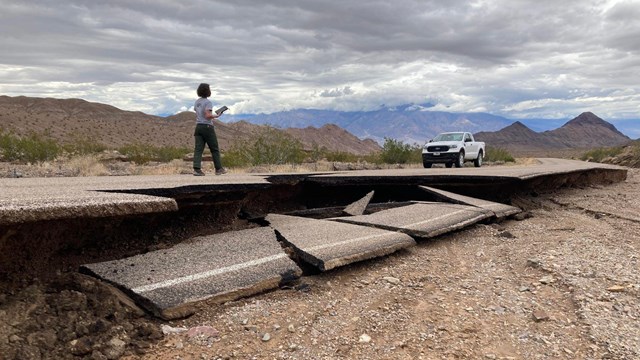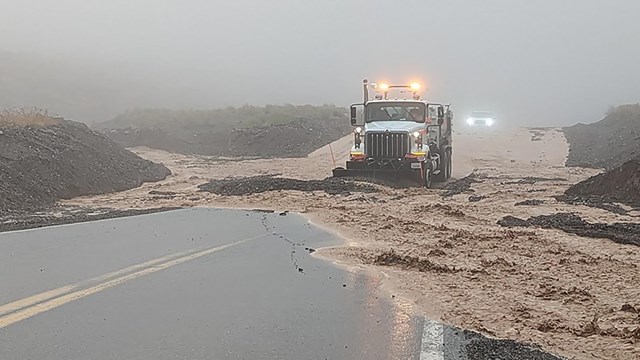
NPS Starting in the late afternoon on Saturday, August 19th, 2023 and continuing on and off until Monday, August 21st, Death Valley National Park was hit by the remnants of Hurricane Hilary. This included heavy rain, which led to flooding in many areas of the park and a parkwide closure for safety. Transcript
Video pans through a rocky desert landscape near Zabriskie Point, where muddy floodwaters rush over paved road and down a hillside and converge into a deep wash (Gower Gulch), while two people watch safely from one of the banks. The sound of rushing water is heard throughout the video.
Visit our keyboard shortcuts docs for details
Flooding caused by heavy rain on Sunday, August 20, 2023 in Gower Gulch near Zabriskie Point. Many people visit Death Valley to enjoy the incredible views, including canyons and alluvial fans. These features are formed largely by flood events, which can sometimes be quite dramatic and can significantly impact human infrastructure. 
Park Roads & Current Conditions
Current information about roads and other current conditions, delays, and closures in the park. 
Highway Conditions
California Department of Transportation road status. Common Questions Click the arrows by the topics below for the answers to common questions about the impacts of the flooding.
Many roads and popular destinations within the park reopened on 10/15/2023. After months of work, most roads have reopened, but a few backcountry roads remain closed. A full assessment has not yet been completed, but contractors on site have reported minimal water damage. Preliminary assessments suggest that the flood mitigation work completed following the 2015 flood which closed the Scotty's Castle area, sucessfully protected the historic structures. Devils Hole: The impacts of Hurricane Hilary at Devils Hole were minor. Floodwaters deposited fine sediment on the shallow shelf of Devils Hole, which is critical foraging and spawning habitat for the Devils Hole pupfish. In some deserts, flooding leads to beautiful flowers within a few weeks. Here in Death Valley, hot temperatures delayed the blooms to winter and spring, when localized patches of impressive blooms were seen throughout the park. Although there was not a park-wide superbloom, the flowers were quite beautiful and abundant. News Releases |
Last updated: April 12, 2025
